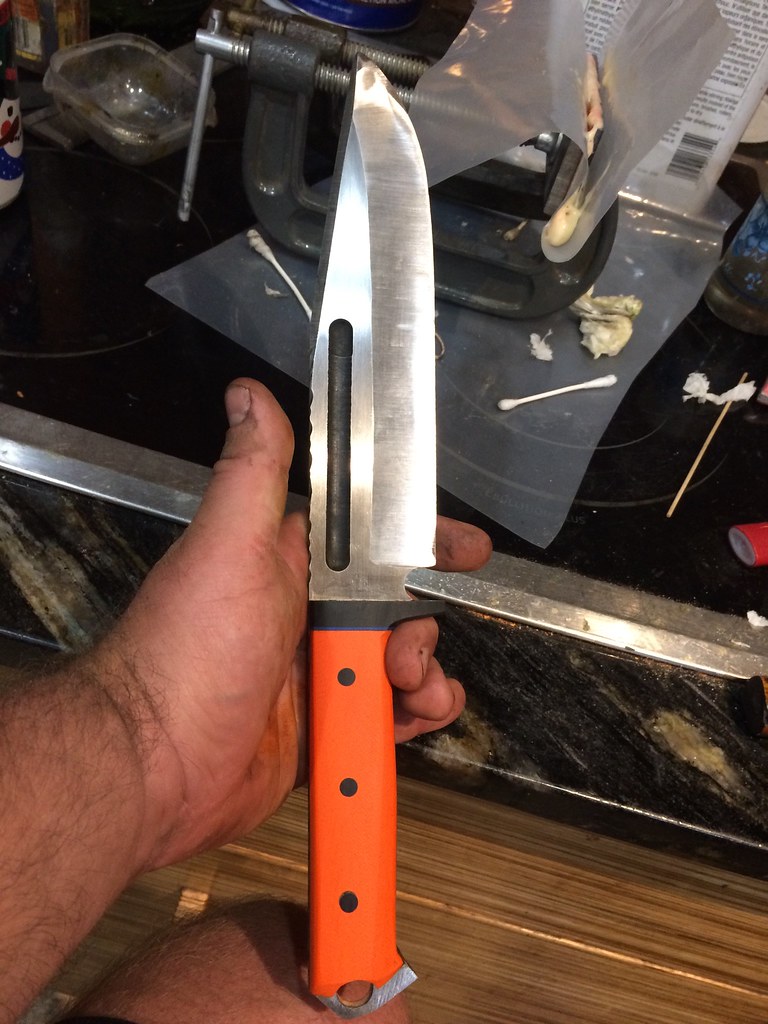1095 at 57-58 is pretty mediocre, but that's similar to leaving W2 or Hitachi White that soft. Where it shines, when it's a good melt, like Hitachi White, W2, and other high, simple carbon steels, is at high hardness, and with really fine grinds.
Although comparing any steels, without any specifics on HT recipe, especially alloys like O-1, is pretty fruitless. O-1 can do some insane stuff, with some highly complicated, (non industry spec) and specialized HT. I'm sure 15n20 can also, but it shines in its toughness to cost to available form ratio, not fine edge stability.
You want something that can chop through antler and still have a "good" edge? Both 15n20 and O-1 can do that with targeted HT, and higher than expect RC. However, IMO, neither will have the kind of edge a zero ground, super thin blade of Hitachi White, old school W-2, or top shelf 1095 at 62-63 RC with refined grain prioritized. On the other hand, those examples will be much less tough, which of course, can be accommodated for, by changing thickness, taper, and edge geometry, you're still prioritizing edge acuteness over edge holding though.
15n20 seems to fill a big niche in it's primary market, because it offers good toughness to cost ratio. The added nickel comes at a premium, but it's minute compared to specialty super tough steels, when you're talking dozens of ft per blade, where you want them to break or wear out at roughly equal rates. That's the trick right? These blades are rarely reground because it's impractical, and they're never patched back together for the same reason, and it makes more sense economically, to simply replace them. So when they get too dull, they break, at about the right time they're becoming problematic in the cut.
It's not that 15n20 is the toughest, or the sharpest, or holds the best edge. It's that it has the best performance, to cost ratio, in a highly specific scenario.
The reason many production outfits use 1095 at lower hardness is because a) it's the cheapest high carbon steel on the market, in almost all cases. It can often be had in volume for $1.50 a lb (I've never paid more than $2lb for it, where 15n20 is almost always more than double this directly from uddeholm/volstepine), and it has a pretty narrow spec range, so you can usually assume that it's decent quality regardless of the provider if it meets spec and has certs. and b) they leave it at crap hardness because of the market's seeming demand of insane "no questions asked" warranties, and that has to accommodate the lowest common denominator. Even still, it gives decent performance, and any outfit can HT it with acceptable if mediocre results.
15n20 even at wholesale rates costs at least double, with a surcharge for nickel based on the current price of nickel, the specific brand name is only available from one place, although there are equivalents. It's also more difficult to process in many cases, even if you waterjet, it's tougher on tooling, belts, whatever.
All that of course makes you think that it's "obviously better", but once you factor the extra cost, the question is; is it more profitable to use than some high alloy carbon or stainless, that can give much better performance, without much if any added cost? Steel cost itself being typically secondary to tooling and consumables, and uddeholm being particularly resilient toward offering competitive pricing.
Personally, I have to say, as someone that uses a thousand lbs of 15n20 a year making damascus now, that I don't particularly see the appeal. For mono carbon, I greatly prefer W2, and if I want something tougher, or with insane wear resistance, and I'm going to deal with the added difficulty, I'd prefer something that associates a premium, such as some of the super stainlesses, that can be had in a wider variety of thicknesses, from a company that isn't a pain in the ass to do business with. 15n20 can't be beat for damascus with 1075, 1084, 1095, W2, or any other simple carbon steel in that spec range, but the nickel doesn't add much for me personally, other than acid resistance. Let's remember it's basically just 1075 with ~2% nickel, nothing crazy, and a pretty textbook alloy if you consider how precisely targeted it was from a market penetration standpoint. Ultimately though I think "toughness" is overblown in many cases, except when you're talking about super alloys which you can leverage it's toughness into insane geometry and dimensions, which of course ironically, is almost never the case when any, including 15n20 are applied, it's simply there for piece of mind in a sharpened crowbar that would already survive a directly nuclear strike even if were made from chinese junk steel.
All in all, we're still talking in vague, esoteric terms, regardless. Ultimately the question is; "What's the best steel and HT for the type of, and way I make knives" or "How can I change the way and style I make knives, to be optimal for the type of steel I want to use" Anything else is just pissing in the wind.
Edit: Just want to add, it probably sounds like I'm saying that I don't favor 15n20, which is absolutely not the case. It's great steel for what it is, and it fills a very important niche for many of us, which is of course residual to it's original industry niche. I just don't find it that spectacular as a mono-steel choice personally, considering the alternatives, that I can get, when I compare the difference in wholesale cost vs the potential return. Hope that makes sense, and nobody that loves 15n20 as mono takes offense.


 IMG_1196
IMG_1196